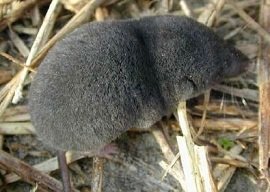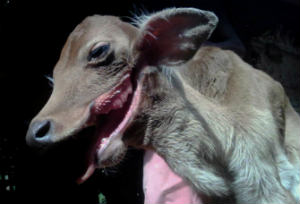Shrew Hybrids
Family Soricidae
EUGENE M. MCCARTHY, PHD GENETICS
|
|
 Southern Short-tailed Shrew
Southern Short-tailed ShrewBlarina carolinensis |
Note: Benedict (1999a, p. 138) says, “fossils suggest that abrupt parapatric boundaries may have occurred in the genus Blarina for the last several thousand years. Short-tailed shrews are fairly common in Pleistocene and Holocene deposits, but sites containing more than one species in the same stratum are unusual and often located near the present contact of those same species.”
Blarina brevicauda [Northern Short-tailed Shrew]
× Blarina carolinensis [Southern Short-tailed Shrew] NHR(southeastern U.S.). Parapatric contact zone (southern Virginia). Tate et al. 1980.
× Blarina hylophaga (↔) [Elliot’s Short-tailed Shrew] ENHR(central U.S.). HPF. There is a narrow hybrid zone in southern Nebraska, southwestern Iowa and northwestern Missouri. Having sampled 1,324 shrews from the zone and adjacent areas, Benedict (1999a, p. 135) says, it “averaged 1.48 km in width (range = 0.64-2.90 km), and only two individuals were captured > 2 km inside the range of the other species. The hybrid zone follows an irregular course, is not associated with any obvious soil or vegetative ecotone, and is capable of rapid movement, having shifted ca. 2.4 km S in 22 months at one site.” Indeed, the region of Nebraska where Benedict carried out his study is quite uniform with respect to most environmental factors. Benedict (1999a, p. 139) notes that the zone often (five of seven sites where accurately mapped) coincided with partial barriers to dispersal (e.g. streams, highways). For example, in Adams Co. it straddled West 12th Street between the towns of Hastings and Juniata. When it rapidly shifted 2.4 km to the south, it stabilized thereafter on Highway 34. In genetically identified hybrids, mtDNA haplotypes were derived about equally from both parental sources, which suggests there is little bias in the directionality of the cross. These shrews differ with respect to karyotype (B. brevicauda: 2n = 48-50, FN = 48; B. hylophaga:2n = 52, FN = 60-62). Benedict 1997, 1999a, 1999b; Genoways and Choat 1972; Thompson 2011.
Blarina carolinensis [Southern Short-tailed Shrew]
See also: Blarina brevicauda.
× Blarina hylophaga [Elliot’s Short-tailed Shrew] NHR(central U.S.)? Citing George et al. (1981), McCay notes that “many individuals attributed to B. c. carolinensis in Arkansas may have been B. hylophaga,” which suggests that these specimens may be intermediate.
Blarina hylophaga [Elliot’s Short-tailed Shrew] See: Blarina brevicauda; B. carolinensis.
Crocidura cossyrensis [Pantellerian Shrew]
× Crocidura russula [Greater White-toothed Shrew] CHR. HPF(♀♀). DRS. The hybridization experiments were conducted with C. russula parents from Switzerland. On the basis of karyotype similarity and low genetic distance, Vogel et al. suggest that C. cossyrensis is conspecific with C. pachyura from Tunisia (which is near the island of Pantelleria). Vogel et al. 2004.
Crocidura pachyura [Greater White-toothed Shrew] See: Crocidura cossyrensis × Crocidura russula.
Crocidura russula [Greater White-toothed Shrew] See: Crocidura cossyrensis.
Myosorex varius [Common Forest Shrew] Bedford et al. (1998) say that the reproductive tract of this shrew combines characters specific to Soricinae and Crocidurinae and that “the ‘hybrid’ character of the reproductive system of Myosorex is more consistent with the proposal that the genus is a survivor of a primitive subfamily—the Crocidosoricinae—from which present day Soricinae and Crocidurinae have arisen.” An alternative hypothesis might suppose that M. varius is derived from hybridization between a member of Soricinae and a member of Crocidurinae.
Sorex araneus [Common Shrew] This shrew is highly variable with respect to karyotype. Differences are with respect to Robertsonian (centric) fusions and whole-arm reciprocal translocations. A variety karyotypically defined groups are recognized. Hybrid zones occur where these populations come into contact. In some cases, karyotypic differences between such populations are so great that rings and chain configurations occur at meiosis I in the hybrids. Searle (1993, p. 323) says, “These complex [structurally] heterozygous hybrids may, in general, be assumed to have lower fertility than single (or low multiple) simple heterozygotes.” Andersson et al. 2004; Balloux et al. 2000; Banaszek et al. 2000a, 2000b, 2002, 2003; Brünner and Hausser 1997; Brünner et al. 2002; Castagne et al. 1994; Chętnicki et al. 1997; Fedyk et al. 1991, 2000; Frykman and Bengtsson 1984; Giagia-Athanasopoulou and Searle 2003; Jones and Searle 2003; Lugon-Moulin et al. 1997, 1999; Mercer et al.1992; Moska 2003; Narain and Fredga 1996, 1997, 1998; Polyakov et al. 2002, 2003; Ratkiewicz 2000, 2003; Searle 1990; Szalaj et al. 1995; Wallace et al. 1991; Wojcik et al. 2002; Zima et al. 2003.
Sorex bairdii [Baird’s Shrew] See: Sorex obscurus × S. pacificus.
Sorex cinereus [Cinereous Shrew]
× Sorex haydeni [Prairie Shrew] ENHR(w U.S.). Bidirectional, mtDNA gene flow occurs in Alberta and Minnesota. However, these shrews are morphologically and karyotypically distinct. Brunet et al. 2002; Demboski and Cook 2003 (p. 151); Stewart and Baker 1994, 1997.
Sorex fumeus [Smokey Shrew] Two populations (fumeus, umbrosus), treated as races of this shrew, have a hybrid zone in New England (USA) and western New Brunswick (Canada). Jackson 1928; Owen 1984 (p. 1).
Sorex haydeni [Prairie Shrew] See: Sorex cinereus.
Sorex monticolus Montane Shrew] See: Sorex cinereus.
× Sorex pacificus [Pacific Shrew] NHI(Pacific Northwest, U.S.). Carraway (1985, p. 1, citing Hennings and Hoffmann 1977) says, “some specimens [of S. pacificus] collected in the northern portion of the known range, near the area of contact with S. monticolus may have a small squarish ridge on the median margin of the first upper incisors” (which suggests gene flow between from S. monticolus into S. pacificus).
Sorex obscurus [Dusky Shrew] (=monticola)
See also: Sorex bairdii.
× Sorex pacificus [Pacific Shrew] ENHI(northwestern U.S.). In Washington and Oregon several populations (bairdii, permiliensis, setosus, yaquinae) form a morphological bridge between Sorex pacificus (Oregon, northern California) and S. obscurus. Hennings and Hoffmann (1977, p. 19) say these populations form a cline in body size connecting S. pacificus and S. obscurus (= monticola of Hennings and Hoffmann) which “represents genic introgression, the nature of which is poorly understood.” Hennings and Hoffmann (p. 18) say yaquinae ranges southward from the Siletz and McKenzie rivers, near Albany and Eugene, “where it may hybridize” with bairdi and permiliensis. They also say (p. 14) that obscurus “grades into” (i.e., hybridizes with) setosus in the Washington Cascades and that obscurus (morphologically?) “approaches” permiliensis and bairdii in western Oregon. Findley lumped pacificus and obscurus, but they are often treated separately. He also lumped the four bridge taxa (bairdii, permiliensis, setosus, yaquinae) under obscurus, but Duff and Lawson (2004) treat bairdii as a species. Taken together these facts suggest the four bridge populations as PHPs of this cross. Brown 1974 (p. 303); Findley 1955 (p. 35).
× Sorex vagrans [Vagrant Shrew] ENHR(northwestern U.S., southwestern Canada). HPF(vh). These taxa, once treated as separate species, were lumped by Findley (1955, pp. 43, 44-45, 51, 54) due to hybridization. He says obscurus occurs at higher elevations than vagrans and that hybrids occur in transitional zones of contact (southeastern British Columbia, Idaho, northeastern Washington, western Montana). Hybridization occurs also further south, in the Rocky Mountains through Utah and into northern Arizona and northern New Mexico. He further states that vagrans is found in the lower elevations west of the Wasatch and Uintah mountains, obscurus in the higher and that hybrids occur where their ranges abut. Brown 1974 (p. 303); Clothier 1950; Hennings and Hoffmann 1977 (p. 21).
Sorex ornatus [Ornate Shrew]
× Sorex sinuosus [Suisun Shrew] ENHR(w U.S.). The Suisun Shrew occurs only in isolated remnants of natural tidal and brackish marshes along the north shore of San Francisco Bay (Grizzly Island and adjacent areas along San Pablo and Suisun bays). It is listed as a Federal Species of Concern and a California Species of Special Concern. Just west of Suisun Slough, on the edge of the marsh, S. sinuosus has a hybrid zone with the upland S. ornatus (Jackson 1928; Rudd 1955). For this reason sinuosus is now usually treated as a subspecies of the far more widespread S. ornatus, which occurs as far south as Baja California (Brown and Rudd 1981; Williams 1979). Rudd (pp. 29-30) also reported a hybrid zone between S. sinuosus and S. vagrans at the mouth of Tolay Creek. This latter finding prompted suggestions (e.g., Hall, Ingles) that S. ornatus be lumped under S. vagrans, a mode of treatment still followed today. A survey of mtDNA haplotypes (Maldonado et al. 2001) found that sinuosus from Grizzly Island and S. o. californicus from surrounding mainland marshes (Rush Ranch) grouped with S. vagrans haplotypes. This suggests that mitochondrial gene flow from S. vagrans into sinuosus and californicus has occurred. Mondonaldo et al. 2004 (pp. 890, 892), confirmed Rudd’s report of variable morphological intermediates at Tolay Creek and found a similar population at Dye Creek (pp. 889, 892), where they say shrews morphologically similar to ornatus are genetically similar to vagrans. However, Brown and Rudd (1981) could find no karyotypic difference between the Tolay Creek population and S. ornatus. S. vagrans occurs at higher latitudes and elevations than S. ornatus so there may be an uninvestigated ACZ (northern California). Hall 1981; Ingles 1965; Jackson 1928; Owen and Hoffman 1983 (p. 4); Rudd 1955.
Sorex pacificus [Pacific Shrew] See: Sorex monticolus; S. obscurus.
Sorex sinuosus [Suisun Shrew]
× Sorex vagrans [Vagrant Shrew] ENHR(w U.S.). See: Sorex ornatus.
Sorex vagrans [Vagrant Shrew] See: Sorex obscurus; Sorex ornatus × S. sinuosus; Sorex sinuosus.
Suncus murinus [House Shrew] Axenovich et al. (1998) reported that male hybrids between populations treated as subspecies of this shrew are sterile.
By the same author: Handbook of Avian Hybrids of the World, Oxford University Press (2006).
 A dog-cow hybrid?
A dog-cow hybrid?